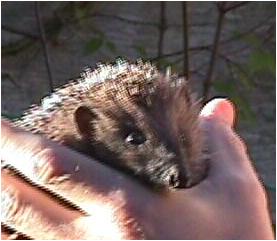

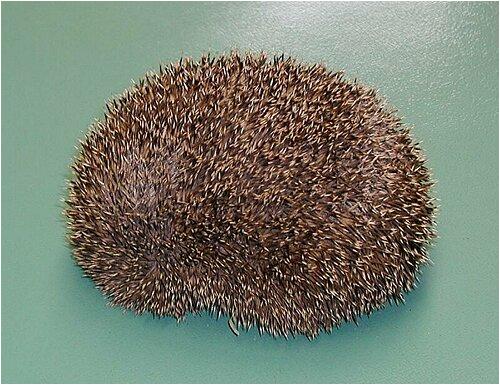
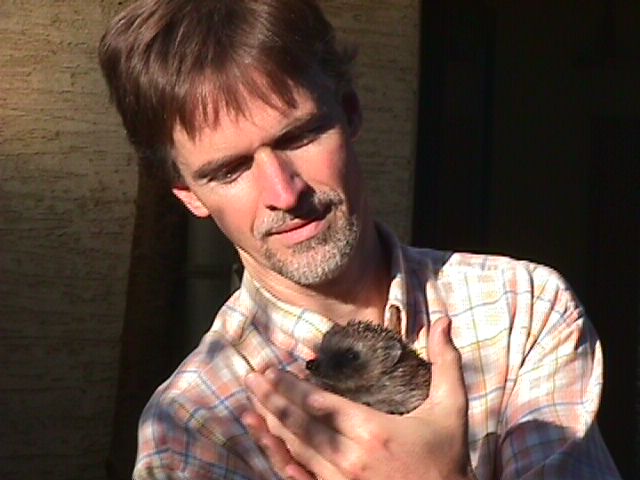
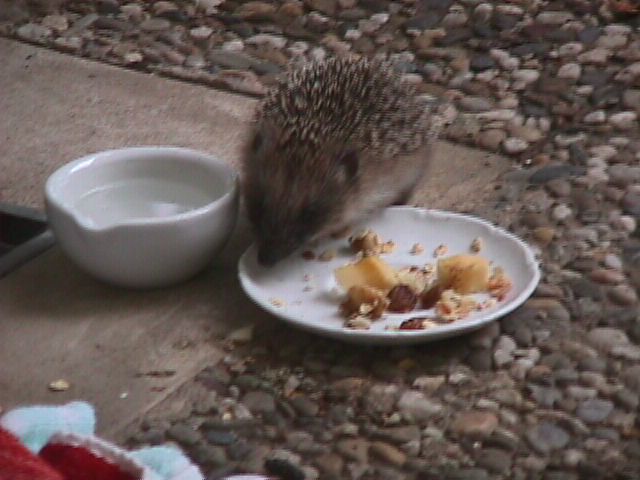
| Caring for hedgehogs | Nature conservation |

Don't worry, no hedgehog will neither be programmed nor being automated here, but
the focus is our assistance for weak, ill or very young hedgehogs at the beginning of autumn and during the winter.
Hedgehogs are protected animals by German law because their population is endagered. It is prohibited to bother,
injure or to kill a hedgehog. It is also not allowed to catch and keep these animals unless they are in a critical condition.
We are now end of november and the little girl with a weight of 340 g is still a baby or a toddler.
I picked up the small animal at the end of september with a weight of only 175 g. Since then I keep it inside my house getting it through the winter without hibernation.
For an outdoor hibernation a hedgehog must have at least 500 g. To survive the winter period it consumes a third of its weight.
Visiting the veterinary surgeon
In the "wilderness" hedgehogs live with a whole set of parasites. Fleas and ticks belong to the visible ones.
While fleas are unpleasant, ticks are even dangerous for us. They can cause meningitis. It is thus preferable to start a preservation by visiting
a veterinary surgeon. In the meantime I consulted the veterinary surgeon twice.
He removed the fleas and gave her injections against the interior parasites.
Now my hedgehog does not have any ticks or fleas at all. Hence one must not fear a transition of parasites.
A greater part of the veterinary surgeons treat hedgehogs without requesting money.
They understand their work as an active contribution to nature conservation.
Behaviour
Hedgehogs are headstrong loners. They live nearby men but however a hedgehog remains a wild animal which means,
he is not tameable and cannot be domesticated like a guinea pig. Anyway it is better for him not to become too
confiding during the period of preservation. Because after he will be released into nature at the end of April,
early in May he might perhaps meet humans who will not treat him as kind as we do. It is advantageous for these
animals to conserve their natural reflexes e. g. to curl up into a ball.
Hedgehogs are night active animals. They move around during the darkness to search for food. During the day
they sleep at a protected place e. g. under leafage. They do not require absolute silence and will not be disturbed
by human voices and the normal daily silent environmental noises. However one should avoid loud noise.
If one approaches a hedgehog, it often forms itself to a prickly egg.
It expresses its displeasure by a quiet rattling breathing and also occasionally by violently hissing.
It bites only in rare cases, e. g. if one causes pain to him. If one grabs the animal - e. g. to clean its enclosure -
it curls up but it does not bite however.
Hedgehogs are no rodents, they do not nibble at things as for instance rabbits, mice and hamsters do.
That is why a hedgehog can be kept it in a large cardboard or in a box made of wood. Hedgehogs are capable to climb
but they often do not fall securely to their feet. Their home has to be prepared accordingly to avoid accidents.
Nutrition
Hedgehogs are omnivores, they mainly live on insects and molluscs.
In autumn they also eat windfall, that is all possible (indigenous) sorts of overripe fruits.
The basic fodder during the preservation consists of a sort of "Müsli" e. g. from the company CLAUS.
It contains nearly all ingredients for a complete nutrition of full-grown and young hedgehogs. I complement
baby's basic food with a level teaspoon of living mealworms. You can also replace them by cat's food.
My hedgehog loves ripe banana cut into pieces.
Quantity of fodder:
Hedgehogs do not tend towards overeating, it means you can offer them great quantities of fodder, they only take
as much as they need. But if they have few opportunity to move around they eat too much due to feeling bored
- as we often do. One should control the quantity of the fodder. "My" hedgehog gets half a bowl in the evening.
A hedgehog only gets water to drink! Never give him milk!
Keeping
A hedgehog needs at least 2 m2 to move during a hibernation without sleeping.
At the beginning I could not supply this area to him. He had to be satisfied with a big cardboard.
The bottom of this "enclosure" has an inlay made of cardboard, which is covered with plastic foil to increase
the lifetime of the bottom. The bottom of the cardboard is to be covered with 3 layers of newspaper and with few
wood shavings. His refuge consists of a little cottage made of wood which I fill with crumpled paper.
In the meantime "my" hedgehog has moved. I built a wooden box with a surface of 1 m2.
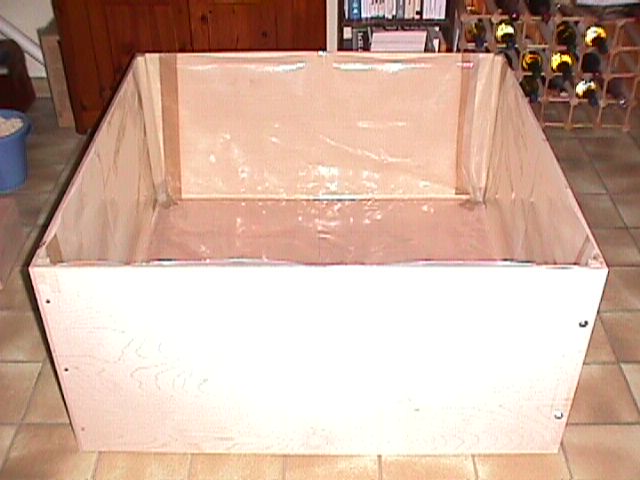 The walls are 50 cm high. With a volume of half a m3 the box fits through any door
in case it has to be moved. In its disassembled state the 6 parts need only few space. The interior is covered
with an inlay of foil of 0.2 mm thickness, which is normally used for construction. This facilitates the maintenance
of the enclosure. For people who are interested in the construction of the enclosure I will gladly send the plot.
The walls are 50 cm high. With a volume of half a m3 the box fits through any door
in case it has to be moved. In its disassembled state the 6 parts need only few space. The interior is covered
with an inlay of foil of 0.2 mm thickness, which is normally used for construction. This facilitates the maintenance
of the enclosure. For people who are interested in the construction of the enclosure I will gladly send the plot.
The environmental temperature should not be lower than 15 degrees celsius and the enclosure should be exposed
to daylight for the animal can live in its day-night-rhythm.
Due to the little prickle rat tries to escape during the night, its enclosure is often pretty digged up
next morning. I gave up to maintain order. The hedgehog feels more comfortable under the leafs of the newspaper
than in its cottage. If one disposes of its excrements along with the surrounding wood shavings at regular intervals,
the maintenance interval for the enclosure is about 3 days. To clean its enclosure the hedgehog should to be moved
every 3 days to a (smaller) cardboard, which is high enough. The one who has sensitive hands should use gloves
for gardening to take the hedgehog. After cleaning its box the bottom is to be covered with newspaper and few of wood shavings.
Hedgehogs are able to swim but they are not even persevering and they do not go into water voluntarily. In our man-made
landscape ponds with steep banks often constitute fatal traps for these animals. During the period of a keeping you
can prepare a hedgehog to such unvoluntary baths and increase its chances of survival by letting it swim occasionally
(1 time a week). In addition the contact with water counteracts the desiccation of its skin. In nature hedgehogs move
in the moist environment of the ground which is covered with plants.
But please - do not throw the hedgehog into cold water to toughen him up! Even young hegdehogs never got in contact
with water. You have to proceed the same way as with a baby or with a toddler:
You fill a bathtub with water 10 to 15 cm deep. The water temperature should be as it is suitable for little
children about 34 degrees celsius. You have to put the animal slowly into the water to give him time to recognize
the situation and to keep its head over water. While proceeding gently the hedgehog does not panic, but it starts
to paddle automatically with its fore and hind legs well-coordinated. If you feel that the hedgehog gets into a panic
you will help him by supporting its fore paws with your fingers. Its body will be erected thereby and with its hind
legs he gets in contact with the bottom of the bathtub. In general the hedgehog swims in the bathtub and tries to
climb the walls. Grant him some pauses by supporting him. After a while the animal becomes calm, its movements
become more restful. After 10 minutes swimming at the latest you finally get out the hegdehog of the water and put
him into a dry towel.
Contact for additional consultancy:
Robert Warnke
Saarbrückener Straße 79
D - 53117 Bonn, Germany
| Phone: | +49 228 67 72 87 |
| Fax: | +49 228 68 96 347 |
| Cellular: | +49 163 78 53635 |
| E-mail: | Robert Warnke |